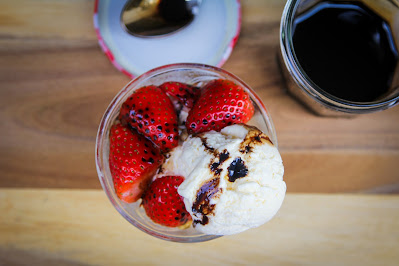I remember my first espresso. I had just arrived in Milan in the December of 2013, a few days before Christmas. It was bitterly chilly, and was already late into the night when we stumbled into Pizzeria da Pino for dinner. (As a brief aside, their pizzas were a revelation to a 20-year-old young 'un, who had only just begun to realise how good pizza can be.) As we were finishing up our food, I struck up a conversation with one of the guys behind the counter, and mentioned in-passing that I have never had an espresso before. He was stunned speechless, before insisting on giving me my first espresso right there, just so that I couldn't say that ever again. And he did just that: una tazza di caffè espresso, served on a saucer with a small piece of chocolate. This restaurant cemented three things in my mind: one, how wonderful pizzas are; two, how warm the Italians are; and three, how good an espresso is.
I’ve came back from that trip clutching several moka pots, the quintessential Italian stovetop espresso maker. How prevalent is it? At one point, 9 in 10 households own one. My own moka pot accompanied me on my university days, keeping me well-caffeinated throughout my studies.
I was living in Melbourne in the 2010s, and there was a large Vietnamese town where I frequented and I bought a phin for Vietnamese drip coffee. I used it quite a lot back then, and savoured the heady aroma of ca phe brewing from my side table. Over the years, my phin fell by the wayside, until my recent trip to Hanoi rekindled my spark and I bought a large-sized version to brew for my entire family. The brewing process is actually quite fast if you do it right: the secret is to brew the ca phe over a vessel that allows the air to circulate out as the pot fills up with coffee (I use a tea pot.)
As I begin working, I spent several years drinking cold brew, as it can easily be prepared in bulk for the week ahead. The ratio, for those who are interested, is 1:6 (150g of ground coffee for 900g of water), which you steep overnight and then strain after. It’s meant to be steeped in room temperature, but in a tropical climate, I do so in a refrigerator.
On the weekends, I use the classic French press. My recipe came straight from the venerable James Hoffmann’s 3-minute guide, where you steep 15g medium ground coffee in 250g boiling water, for at least 5 minutes. This ratio can be scaled up or down, or tweaked for individual preferences, but so far, I'd not known anybody who had anything bad to say about this recipe.
But finally, I've come full circle, and bought an espresso machine: a Breville Bambino, paired with a Turin SD40 grinder.
 |
| Too soon for a mid-life impulse purchase, you say? Well I’m gonna have one anyway. |
Home Espresso machines run the gamut from beginner to “prosumer”. Fancy Italian machines which let users play with every variable that goes into making an espresso is like a Ferrari: you get superb results in the hands of people who know what they’re doing, but a beginner is more than likely to crash and burn. A Breville is like a Toyota: it's easy to use and produces reliably decent espresso. It automates a bunch of stuff to keep beginners from becoming overwhelmed, at least until they become acquainted with the espresso basics. A novice can use preground coffee beans, mess up every step and still turn out adequate espresso from their first attempt. From there, their cup of joe only gets better. My daily workhorse are Robusta beans, which are a quarter of the price of Arabica beans. But even so, my coffee tastes - and looks - better than one from the average coffee shop. After adding milk, most people will be hard-pressed to taste the difference between Robusta and Arabica beans.

I've been having a lot of fun experimenting with different coffee beans and dialing the beans in to make espressos, ristrettos and lungos. I probably also spent an inordinate amount of time reading up milk-based recipes from the common lattes, flat whites, cappuccinos and macchiatos to the more obscure drinks (the cortado, magic and piccolos.) The literature was not straightforward, to say the least. Recipes from one well-regarded source can (and often do) contradict another reputable source. It was maddening at the start, but I think this quirky trait is just proof of how consumers' tastes have evolved over time. A traditional cappuccino is 1/3 foam, 1/3 milk and 1/3 espresso, a proportion that is well-publicised, oft-repeated, and probably suits no one’s tastes these days. A glob of foam with no latte art is viewed as poor form. And dry foam filling up 1/3 of the cup? Sacrilegious. As the industry (and consumers’ tastes) matured, modern recipes drifted away from their original versions. But their iconic names stuck.
Another possible reason for the shift was that drink sizes grew larger over the years. When espresso culture started in the nineteenth century, a shot of espresso was the default. With increasing drink sizes over the decades, a “double shot” of espresso became the norm, lest all the milk drown out the taste of espresso. But even as we doubled the espresso content, most traditional recipes still produce too small a beverage for consumers. Coming back to the classical cappuccino recipe, a double shot of espresso yields about 40ml, and the final drink size would be 80ml of beverage with 40ml of foam. In today’s context, 120ml is a minuscule cup. So instead, a modern-day cappuccino is taken to be a latte with a bit less milk, and likely with a dusting of cocoa powder over the top.
Instead of giving firm ratios on espresso-milk drinks, most recipes are guided by cup sizes. A cappuccino cup is smaller than a latte cup, and a piccolo cup is the smallest of all. All a barista has to do is to use the correct cup, put a double shot of espresso in and then fill up the cup with milk. One coffeeshop's cappuccino could be another's latte. But ultimately, it's more important for the drinks that you make to have internal consistency. Your latte should have a little more milk that your flat white or cappuccino, and a lot more milk than your piccolo (or a magic, or a cortado, or … you get the drift). But even that may be coming to an end. Some cafes have done away with the labelling of milk-based drinks altogether, and simply refer to their drinks as “white” or “black”. Even the World Barista Championship renamed the “Cappuccino” section of the competition to “milk-based beverage” in 2016, allowing competitors to use however much milk that they prefer.
 |
| Affogato |
But that’s enough speculation from me, a non-professional who’s late to the game. I'll rather drink more espresso and leave the theory-making to the historians and sociologists. My espresso machine is not just good for making my morning cup of joe: I often also put it to work for batches of affogato and tiramisu (the espresso-Bailey version). When I'm sick of coffee (it does happen), my steam wand does double-duty making hojicha, chai and matcha lattes. Even my nieces’ hot cocoas got my latte art treatment. (My recipe for matcha latte is 4 tsp matcha powder, mixed with a tsp of sugar and 6 tbsp boiling water. Combine with a tiny whisk or a handheld electric frother, run the mixture through a sieve into a latte-sized cup, then add the steamed milk.)
More recently, the new topic on the block is on homemade Nitro Cold Brew, which you can approximate with a steam wand. After all, the air is 70% nitrogen.
 |
| Since I’m using espresso instead of cold brew, instead of calling it nitro cold brew, can I call it cold nitro brew? |
Making espresso at home requires expensive purchases up-front, but at 1+ year in, I've more than broke-even. And even if you're not looking to buy an espresso machine or grinder at this stage, there are so many other ways to brew coffee, which is definitely cheaper than buying a cup every day. But more than cost savings, coffee-brewing is immensely rewarding. It's stepping into a world of new ideas and techniques. YouTube is a great platform for this craft: huge numbers of baristas are sharing their knowledge. Every single thing that I know about pouring these latte art here, I learnt it there. And no matter where you look, from Facebook to Reddit to Discord, there are groups centered around particular espresso machines or grinders where the members discuss troubleshooting to get the best out of their purchase. It's easy to find these groups and find solutions to whatever troubles you're having. And while we're on the topic of hardware, can I also mention that the options available now were unheard of even just a couple of years ago in 2022 when I started? Back then, entry-level grinders weren't good enough for making espresso, and you'll have to spring for something at a higher price range. But in the last couple of years, a slew of capable grinders and espresso machines have been released at entry-level prices (such as the Turin SD40 or the Baratza Encore ESP.) This is a new golden age for home baristas, and there is no better time to enter the coffee-brewing hobby.















